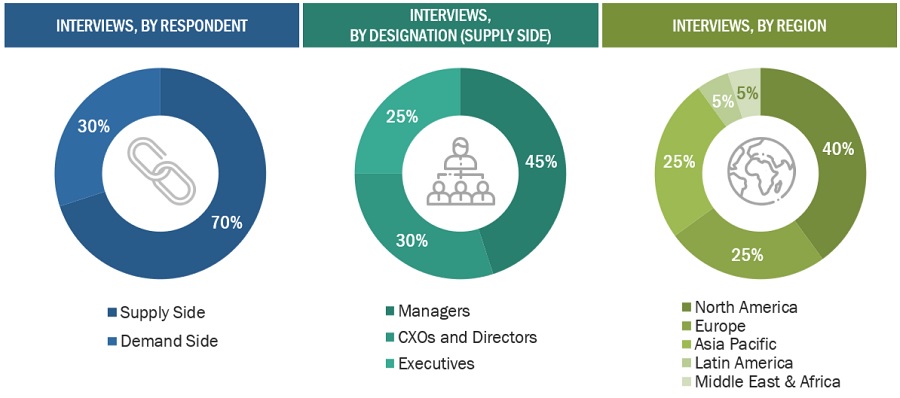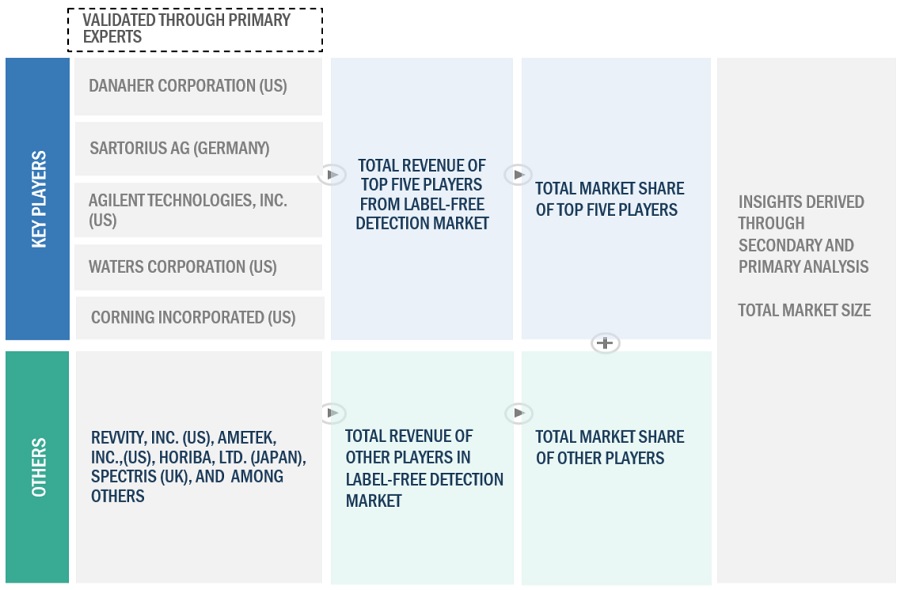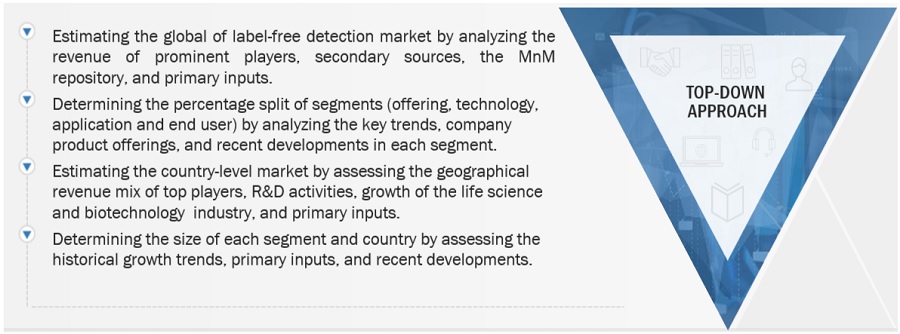This research study involved the extensive use of secondary sources, directories, and databases to identify and collect valuable information for the analysis of the global label-free detection market. In-depth interviews were conducted with various primary respondents, including key industry participants, subject-matter experts (SMEs), C-level executives of key market players, and industry consultants, to obtain and verify critical qualitative and quantitative information and assess the growth prospects of the market. The global market size estimated through secondary research was then triangulated with inputs from primary research to arrive at the final market size.
Secondary Research
Secondary research was used mainly to identify and collect information for the extensive, technical, market-oriented, and commercial study of the label-free detection market. The secondary sources used for this study include World Health Organization (WHO), National Center for Biotechnology Information (NCBI), National Institutes of Health (NIH), US Food and Drug Administration (US FDA), International Molecular Exchange Consortium (IMEx), Biomolecular Interaction Network Database, Nature (Journal), Genome Medicine, PubMed, European Federation of Pharmaceutical Industries and Associations (EFPIA), European Lead Factory (ELF), India Brand Equity Foundation (IBEF), UK Research Partnership Investment Fund (UKRPIF), Pharmaceutical Research and Manufacturers of America (PhRMA), Eurostat, and Factiva, research journals; corporate filings such as annual reports, SEC filings, investor presentations, and financial statements; press releases; trade, business, professional associations and among others. These sources were also used to obtain key information about major players, market classification, and segmentation according to industry trends, regional/country-level markets, market developments, and technology perspectives.
Primary Research
Extensive primary research was conducted after acquiring basic knowledge about the global label-free detection market scenario through secondary research. Several primary interviews were conducted with market experts from the demand side, such as pharmaceutical and biotechnology companies, CROs, CMOs, and academic & research institutes, and experts from the supply side, such as C-level and D-level executives, product managers, marketing & sales managers of key manufacturers, distributors, and channel partners. These interviews were conducted across six major regions, including the Asia Pacific, North America, Europe, Latin America, Middle East and Africa. Approximately 70% and 30% of the primary interviews were conducted with supply-side and demand-side participants, respectively. This primary data was collected through questionnaires, e-mails, online surveys, personal interviews, and telephonic interviews.
The following is a breakdown of the primary respondents:

To know about the assumptions considered for the study, download the pdf brochure
Market Size Estimation
Both top-down and bottom-up approaches were used to estimate and validate the total size of the label-free detection market. These methods were also used extensively to estimate the size of various subsegments in the market. The research methodology used to estimate the market size includes the following:
Bottom-up Approach
-
The key players in the market have been identified through extensive secondary research.
-
The revenues generated from the label-free detection business of leading players have been determined through primary and secondary research to arrive at the overall label-free detection market.
-
All percentage shares, splits, and breakdowns have been determined using secondary sources and verified through primary sources.
-
Additionally, to arrive at the label-free detection market for offering segments, the label-free detection business shares of leading players for separate product category (wherever available) were also gathered from secondary sources. In some instances, the shares of label-free detection product businesses were ascertained through a detailed analysis of various parameters, including product portfolios, market positioning and primary insights.
-
All assumptions, approaches and individual shares/revenue estimates were validated through expert interviews.

To know about the assumptions considered for the study, Request for Free Sample Report
Top-down Approach
After arriving at the overall market size from the market size estimation process, the total market was split into several segments and subsegments.

Data Triangulation
After arriving at the market size from the market size estimation process explained above, the total market was divided into several segments and subsegments. To complete the overall market engineering process and arrive at the exact statistics for all segments and subsegments, data triangulation and market breakdown procedures were employed, wherever applicable. The data was triangulated by studying various factors and trends from both the demand and supply sides.
Market Definition
Label-free detection is gaining widespread acceptance as an important research and development tool in academic research institutes and biotechnology and pharmaceutical industries. It helps in the investigation of molecule-molecule interactions without using additional isotope or fluorescent labels that usually cause spatial interference or quenching.
Stakeholders
-
Pharmaceutical and biotechnology research associations
-
Label-free equipment manufacturers and vendors
-
Research and consulting firms
-
Pathologists and pathology laboratories
-
Distributors of label-free detection equipment
-
Research institutes
-
Contract research organizations (CROs)
-
Venture capitalists
-
Government associations
-
CROs & CDMOs
-
Forensic laboratories
-
Market research and consulting firms
-
Government & independent regulatory authorities
Report Objectives
-
To define, describe, and forecast the label-free detection market based on offering, technology, application, end user, and region
-
To provide detailed information regarding the major factors influencing market growth (such as drivers, restraints, opportunities, and challenges)
-
To strategically analyze micro-markets with respect to individual growth trends, prospects, and contributions to the overall label-free detection market
-
To analyze opportunities in the market for stakeholders and provide details of the competitive landscape for market leaders
-
To forecast the size of the market segments with respect to six main regions: North America, Europe, the Asia Pacific, Latin America, the Middle East, and Africa
-
To profile the key players in the label-free detection market and comprehensively analyze their product portfolios, market positions, and core competencies
-
To track and analyze competitive developments in the label-free detection market, such as acquisitions, product launches, expansions, agreements, partnerships, and collaborations
-
To benchmark players within the label-free detection market using the ‘Company Evaluation Matrix' framework, which analyzes market players based on various parameters within the broad categories of business strategy and product strategy
Available Customizations
With the given market data, MarketsandMarkets offers customizations as per the company’s specific needs. The following customization options are available for this report:
Portfolio Assessment
-
Product Matrix, which gives a detailed comparison of the product portfolios of the top three companies.
Company Information
-
Detailed analysis and profiling of additional market players (up to three).
Geographical Analysis
-
A further breakdown of the Rest of Asia Pacific Label-free detection market into countries
-
A further breakdown of the Rest of European Label-free detection market into countries
-
A further breakdown of the Rest of Latin American Label-free detection market into countries



Growth opportunities and latent adjacency in Label Free Detection Market